I molded together a module called "RazorForSitecore". This module is backed by the open-source Razor Engine* and integrates nicely into the Sitecore presentation engine (how?). It can even be combined with other modules that enable strongly-typed classes to be created from templates (e.g. CompiledDomainModel). This has some benefits like:
- Compile time type checking (views are compiled into memory assembly)
- Intellisense support
The module is available at the Sitecore Shared Source (RazorForSitecore) library. To use the module you have to do the following (detailed description):
- Update IIS application pool .NET version to 4.0!
- Install the package from the Shared Source Library (link).
- Update your main web.config file (see below)
- Create your first Razor View
- Add your view to the presentation details of an item
- Install your strong-typing module
- Create a processor in the "initialize" pipeline that specifies which ITypedModelProvider the module should use
How does this module work?
 The module allows you to create Razor renderings mostly as an alternative to XSLT renderings. XSLT renderings are used for simple presentation elements (from a backend perspective), unlike sublayouts which allow for complex behavior or logic to be implemented. These Razor views cannot contain complex behavior as they are totally unaware of the Webforms lifecycle (they are parsed in a PreRender event of a sublayout).
The module allows you to create Razor renderings mostly as an alternative to XSLT renderings. XSLT renderings are used for simple presentation elements (from a backend perspective), unlike sublayouts which allow for complex behavior or logic to be implemented. These Razor views cannot contain complex behavior as they are totally unaware of the Webforms lifecycle (they are parsed in a PreRender event of a sublayout).When you create a 'Razor view' the module automatically creates an item and a corresponding .cshtml template file. However, it also creates an .ascx sublayout to 'contain' and 'integrate' the Razor template into Sitecore. Don't worry, you don't have to do anything with the file it just sits there and inherits from a base class that contains the logic. The module also sets the parameters 'modelType' and 'razorPath' on the item. Don't change or overwrite these or you will die! :)
Creating view helpers
It is possible to extend the view with helper functions through extension methods applied on the SitecoreHelper class. The SitecoreHelper class is exposed as property "Sc" in the view baseclass. This is an example of an extension method that uses the FieldRenderer control and keeps supporting the Page Editor:
Creating view helpers
It is possible to extend the view with helper functions through extension methods applied on the SitecoreHelper class. The SitecoreHelper class is exposed as property "Sc" in the view baseclass. This is an example of an extension method that uses the FieldRenderer control and keeps supporting the Page Editor:
public static class RenderingHelpers
{
public static string FieldRenderer(this SitecoreHelper helper, Item item, string fieldName)
{
Sitecore.Web.UI.WebControls.FieldRenderer r = new Sitecore.Web.UI.WebControls.FieldRenderer();
r.Item = item;
r.FieldName = fieldName;
return r.Render();
}
}
Here is a detailed description of the steps involved.
1, 2
This really shouldn't be a problem
3. Update your main web.config file
Add the following section element under configSections:
<section name="razorEngine" type="RazorEngine.Configuration.RazorEngineConfigurationSection, RazorEngine" requirePermission="false" />
Add the following razorEngine element under configuration (right above connectionStrings (as sibling) will do):
<razorEngine>
<namespaces>
<add namespace="Sitecore.Sharedsource.RazorForSitecore" />
</namespaces>
<templateServices default="Sitecore.Sharedsource.RazorForSitecore.TemplateService, RazorForSitecore">
<add name="Sitecore.Sharedsource.RazorForSitecore.TemplateService, RazorForSitecore" language="CSharp" />
</templateServices>
</razorEngine>
Find the compilation element (at the bottom of the file) and add/change the targetFramework attribute to reflect "4.0" (changing the target framework under Project properties -> Application will also work):
<compilation defaultLanguage=”c#” debug=”false” targetFramework=”4.0” />
Add the following buildProviders element under compilation:
<buildProviders> <add extension=".cshtml" type="System.Web.WebPages.Razor.RazorBuildProvider, System.Web.WebPages.Razor, Version=1.0.0.0, Culture=neutral, PublicKeyToken=31BF3856AD364E35" /> </buildProviders>
Add the following add elements under assemblies (under compilation). Make sure you remove the existing add element for System.Data.Linq which is probably pointing to version 3.5.0.0:
<add assembly="System.Data.Linq, Version=4.0.0.0, Culture=neutral, PublicKeyToken=B77A5C561934E089"/> <add assembly="System.Web.Helpers, Version=1.0.0.0, Culture=neutral, PublicKeyToken=31BF3856AD364E35" /> <add assembly="System.Web.WebPages, Version=1.0.0.0, Culture=neutral, PublicKeyToken=31BF3856AD364E35" />
In some cases you need to find the providerOption element and change the value to "v4.0". Don't worry if you can't find it, .NET will throw a nice exception if you forget to change it in that case.
<providerOption name="CompilerVersion" value="v4.0" />
4. Create your first Razor View
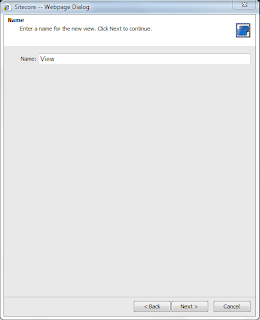 |
| Specify the view name. |
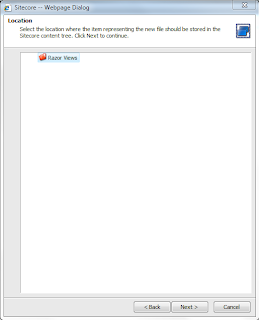 |
| Items belonging to the views are stored in a fixed location. You can create subfolders if you like. |
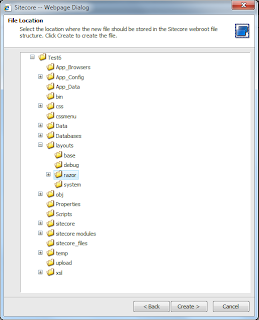 |
| The files (one .ascx 'container' and the .cshtml Razor template) are stored in /layouts/razor by default. You can change this in the /App_Config/Include/RazorForSitecore.config file. |
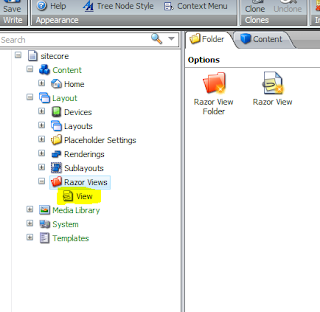 |
| Refresh the content tree to see your view. |
5. Add your view to the presentation details of an item
Additionally: to use CompiledDomainModel as your model provider.
- Install the module as described on the module homepage (link).
- Create a processor for the initialize pipeline that registers the model provider, e.g.
namespace Sitecore.Sharedsource.RazorForSitecore { class RazorProcessor { public void Process(PipelineArgs args) { RazorForSitecore.ModelManager.SetModelProvider(new GenericTypedModelProvider(YourDomainModelNamespaceHere.ItemWrapper.CreateTypedWrapper)); } } } - Register the processor in ~/App_Config/Include/RazorForSitecore.config
Enjoy the module and let me know if you find bugs or have suggestions for improvements!


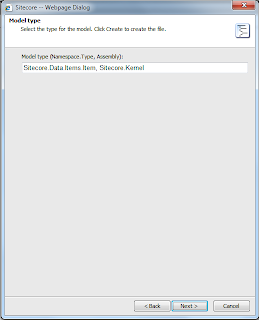

Very cool, I'm trying to get this to work but in the compiler generated code I'm getting an error. Do you have an Extension Method on Sitecore.Context :
BeantwoordenVerwijderenError 107 'Sitecore.Context' does not contain a definition for 'ApplicationInstance' c:\Windows\Microsoft.NET\Framework\v4.0.30319\Temporary ASP.NET Files\root\7c43679a\b7fca37d\App_Web_vdcslm3t.0.cs 42
This might have something to do with Sitecore trying to load the .cshtml file as if it were a .ascx sublayout (or control if you want to call it that).
BeantwoordenVerwijderenHave you added the view in the correct folder using the command template "Razor view"? Can you doublecheck the parameters on the item definition? (should be: razorPath=/somePath/someFile.cshtml&modelType=Sitecore.Data.Items.Item, Sitecore.Kernel). Does the .cshtml file exist? Is the path of the Razor View item pointing to a valid sublayout .ascx file that inherits from the RazorForSitecore.SublayoutBase?
I deleted the view and now I'm having problems with some of the stuff in shell compiling. I think I may start with a fresh project and try testing again when I get some time.
BeantwoordenVerwijderensitecore modules\Shell\RazorForSitecore\Templates\razorview.model.cshtml is failing. I'm having trouble with .cshtml files in general I guess.
You could debug the project and check the InnerException. This contains possible view compile errors. Another issue might be that the name contains a [dot].
BeantwoordenVerwijderenYou can just
1. delete the item definition in the Sitecore tree and
2. delete corresponding .ascx and .cshtml file
3. Restart the application
This should fix your project. Then re-create a Razor view through the wizard and attach that to an item's presentation details
I've been trying to get the extension methods onto the SitecoreHelper working but ran into a few problems.
BeantwoordenVerwijderenIn my solution I've added the extension method like your example above, do I need to define the namespace reference for the cshtml file or is that coded into your RazorForSitecore dll?
I've added to my cshtml file:
@Sc.FieldRenderer(@Model, "Title") but then get ysod 'Unable to compile template. Check the Errors list for details.' - have I missed anything when setting this up? Static html is rendered fine, its when I add the extension method that I encounter the error.
Thanks in advance
@boro2g: The namespace needs to be imported to the view either by supplying it directly on the view with an '@using Namespace' directive or by registering it in the web.config in the views folder.
BeantwoordenVerwijderenGood luck
@Ropstah - that worked great - thanks!
BeantwoordenVerwijderenIs it possible to nest razor views a like you would with standard sitecore placeholders?
Using the normal sitecore layout engine, your ascx would contain eg . Could extensions methods allow for a similar thing?
The desired outcome would be that you have eg
View(outer) with 1 placeholder 'main' &
View(inner) which is setup in sitecore to be rendered in '/main'
Thanks again!
Ah, html was commented out before - the example markup would be eg sc:placeholder runat="server" key="content"
BeantwoordenVerwijderenPlease understand that controls defined on a Razor view will not be parsed as such nor will they be added to the control tree. I am looking for a way to support layouts and partials however I'm not sure how they will fit in the current Sitecore presentation layer.
BeantwoordenVerwijderenI'll get back on this.
I would like to use Razor as the rendering engine instead of xslt in a solution that was just upgraded from 6.5 to 7.0. As far as I can understand from the documentation of mvc in 6.6 and 7.0, I cannot have a mix of web-forms and mvc in the same request. So I am thinking about using this module instead. It just seems a bit strange now that razor and mvc is actually a part of Sitecore out-of-the-box. Is it even possible to use your module with Sitecore 7.0. (it is not listed in the requirements..)
BeantwoordenVerwijderenDeze reactie is verwijderd door de auteur.
BeantwoordenVerwijderenHi. I can add an xml-file to a layout using the sc:XslFile tag. Can I do something similar with a razor file using your module?
BeantwoordenVerwijderenHi Nikolaj, regarding your first question: Sitecore 7.0 already includes MVC and Razor so no need for my module.
BeantwoordenVerwijderenRegarding the second question: there is not a built-in way to statically bind Razor views to the presentation. However you could easily implement your own control which adds this behaviour.